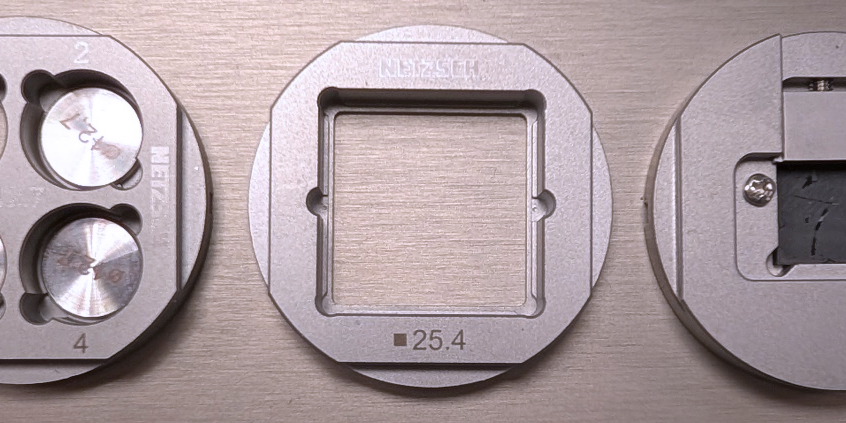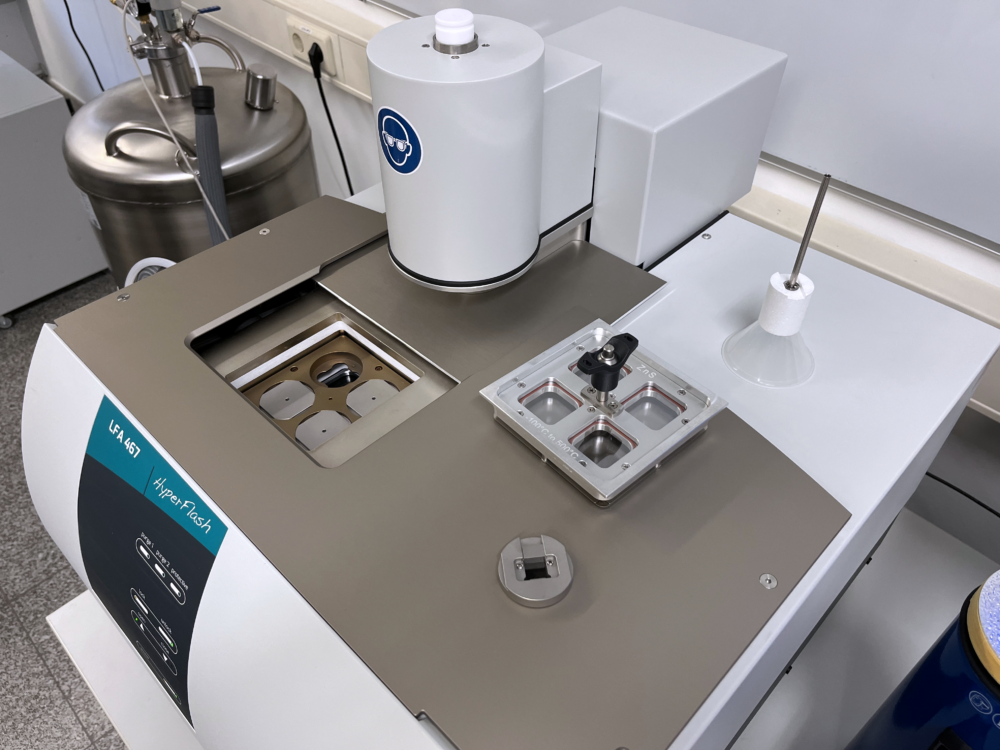Imagine a spacecraft leaving the atmosphere at top speed on its way into boundless space. It is exposed to extreme temperatures – from the icy cold conditions of space to the searing heat of re-entry into the atmosphere. Every material used in such a spacecraft must be able to withstand these temperatures undamaged. But how can it be ensured that a material can withstand such stresses? The basis lies in the precise measurement of the thermal properties of the materials – and this is precisely where the laser flash method comes into play.
This innovative technology makes it possible to determine the thermal conductivity of materials with very high precision. This is particularly crucial for the characterisation of materials used in high-performance applications such as aerospace, but also in the semiconductor industry and cryotechnology. But how exactly does the method work and why is it a game changer for materials research?
How does the laser flash method work?
The laser flash method is based on a simple but extremely effective principle: a short pulse of energy (a laser beam in our system) hits a flat sample and heats it on one side. In a fraction of a second, the heat spreads through the material and an infrared sensor measures how the temperature changes on the other side of the sample. The speed at which the temperature rises on the opposite side depends on the thermal diffusivity of the material. The faster the temperature rises, the higher the thermal diffusivity. Together with the specific heat capacity and the density of the material, additional information can be obtained about the thermal properties of the material, such as the thermal conductivity.
To illustrate this, let’s put ourselves in the shoes of an aerospace engineer. We are planning an interplanetary mission to one of the most interesting celestial bodies in our solar system, Saturn’s moon Titan. It has numerous parallels to Earth, which makes it an extremely interesting research object. To ensure that the structure and the heat shield can withstand the extreme temperatures, the engineers need precise data on the thermal conductivity of the available materials. The laser flash method provides the necessary values in just a few seconds to make the right decision – quickly and precisely. Liquid nitrogen can also be used to reach temperatures of -100 °C, which is the temperature in outer space. If the material density is known, the laser flash method makes it possible to determine the heat capacity of the material directly using a reference sample. As this is a transient method, the temperature is measured over a short period of time with minimal heat loss. But what sets the laser flash method apart from the many other measurement methods?
Why is this method a gamechanger?
The versatility of the laser flash method is impressive, which is why it is suitable for analysing materials in various industries. It works not only for metals, but also for ceramics and polymers or fibre-metal laminates (FML). FMLs are hybrid laminates made of fibre and metal layers. This combination enables additional functionalities, such as integrated conductive tracks or an increase in the perforation resistance in joining areas. The aforementioned wide temperature range covered by the method is particularly noteworthy: it measures temperatures from -100 °C to 1,250 °C and can therefore determine thermal diffusivity at different material temperatures. This makes it an ideal tool for analysing materials in aerospace and cryotechnology.
The LFA467 HyperFlash laser flash analyser has been available at the Institute of Lightweight Systems since summer 2024. Thanks to its ability to measure up to 16 samples simultaneously, it is considered one of the fastest methods in its field and offers the option of measuring both in-plane and out-of-plane. The sample thickness can range from 0.01 mm to 6 mm. The thermal diffusivity measurement range covers 0.01 mm²/s to 2,000 mm²/s, while the thermal conductivity can be determined between 0.1 W/(mK) and 4,000 W/(mK).
The product range of laser flash analysers includes various versions with different measuring ranges. For comparison, the LFA467 HAT HyperFlash enables measurements in a temperature range from room temperature to 1250 °C using a xenon lamp, while the LFA467 can realise a temperature range from -100 °C to 500 °C at the Institute of Lightweight Systems.
However, you may now be asking yourself: why use the laser flash method and not another one? Alternatives for determining thermal conductivity, such as the guarded hot plate method or the heat flow meter, can be found on the market. However, the laser flash method offers decisive advantages: it provides exact values within seconds, requires only minimal sample quantities, uses a simple sample design and, thanks to the short energy pulse, minimises unwanted heat losses, which occur primarily in stationary measurement methods with long heating and cooling times. This not only makes it faster, but also more cost-effective and efficient. Especially when analysing thin samples or materials that conduct heat extremely quickly, the laser flash method offers exceptional accuracy and precision.
Although the laser flash method is one of the most accurate and fastest methods for measuring thermal conductivity, there are boundary conditions which, if ignored, lead to falsification of measurement results. Materials with very high thermal conductivity, such as aluminium or copper, require special graphite coatings to avoid measurement errors due to reflection. If the coating is uneven, the measurement results may be distorted. Modern optimisation techniques and improved coating methods minimise these influences and enable precise measurements.
Conclusion: The future of material analyses
The laser flash method is far more than just a measurement technique – it is a key to new, higher-performance materials for the next generation of spacecraft and high-performance aircraft. It enables engineers to characterise innovative material combinations, including fibre-metal laminates with varying metal contents and different layer orientations. This means that our journey into interplanetary space with newly modified materials may soon become a reality.









